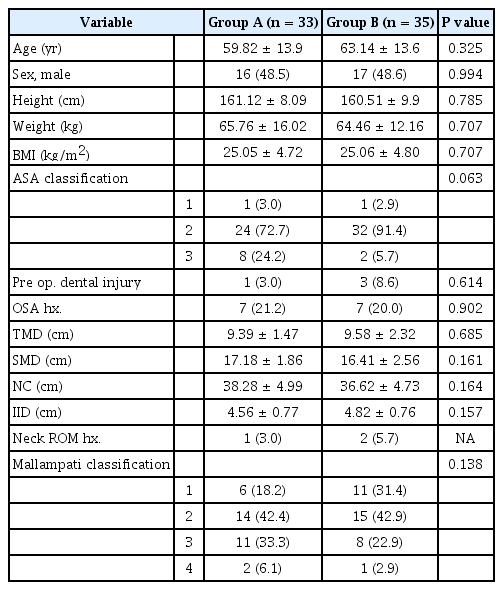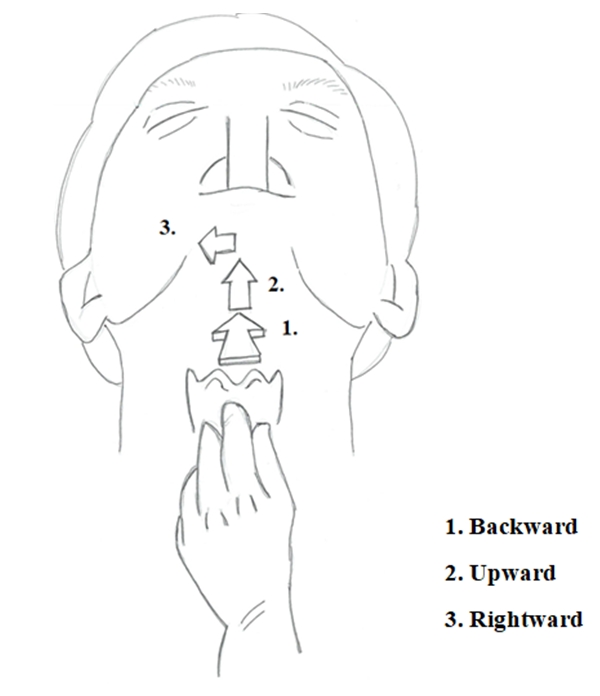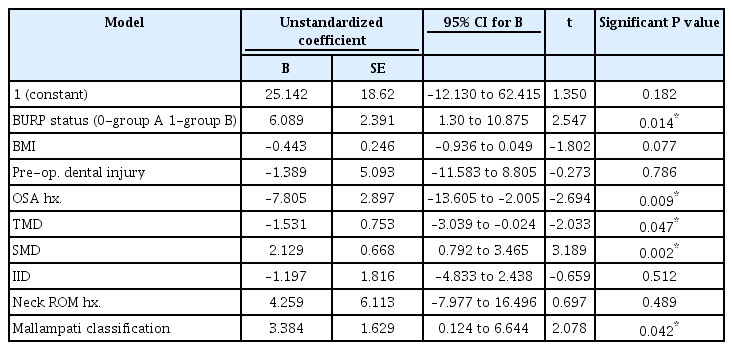The effects of backward, upward, rightward pressure maneuver for intubation using the OptiscopeTM: a retrospective study
Article information
Abstract
Background
The OptiscopeTM and the backward, upward, rightward pressure (BURP) maneuver are widely used in clinical practice because the BURP maneuver facilitates intubation by improving visualization of the larynx. However, the effect of the BURP maneuver is unclear when using the OptiscopeTM. Therefore, we retrospectively investigated the effect of the BURP maneuver on intubation using the OptiscopeTM.
Methods
Sixty-eight patients intubated with the OptiscopeTM were enrolled. We used the BURP maneuver in Group A (n = 33) and the conventional maneuver (which does not use the BURP maneuver) in Group B (n = 35). BURP application status was a binary variable representing whether the BURP maneuver was used during the intubation. A multiple linear regression analysis was performed to assess the effects of the BURP application status on intubation time controlling for body mass index, preoperative dental injury status, obstructive sleep apnea history, thyromental distance, sternomental distance, interincisor distance, history of neck rotation restriction, and Mallampati classification.
Results
There was no difference in the intubation time between the two groups. According to the regression model (R2 = 0.308, P = 0.007), the BURP maneuver (Group A) decreased the intubation time by 6.089 seconds (95% confidence interval 1.303–10.875, P = 0.014) compared to Group B.
Conclusion
The BURP maneuver reduced intubation time when using the OptiscopeTM.
INTRODUCTION
Recently new instruments have been developed for viewing the larynx with video assistance for safe and accurate endotracheal intubation [1]. Among various instruments, video stylets are popular due to their portability, convenience of preparation, and safety [2,3]. The OptiscopeTM (Clarus Medical LLC, USA) is a video stylet made of rigid fiberoscope attached to an LCD monitor with two light sources, allowing intubation to be performed while visualizing the patient’s larynx through the monitor [1,4]. The monitor of the OptiscopeTM is fixed to the handle, thus providing the anesthesiologist a more comfortable and desirable posture during intubation [1]. Previous studies have compared the OptiscopeTM with other intubation devices and revealed that the OptiscopeTM helps reduce the cervical spine motion compared to videolaryngoscopes, and allows for shorter intubation time than flexible fiberoptic bronchoscopes [2,5]. The widely performed conventional maneuver when using the OptiscopeTM consists of a single non-dominant handed chin lift while the OptiscopeTM is inserted with the dominant hand [6].
Alongside new instruments, anesthesiologists perform various maneuvers to manage difficult airways. Applying BURP (backward, upward, and rightward pressure on the thyroid cartilage) maneuver (Fig. 1) is well explained by Knill [7]. The BURP maneuver is a reliable method for improving the management of complex laryngoscopy procedures by improving the visualization of the larynx [8,9]. The OptiscopeTM and the BURP maneuver are independently used widely in different clinical practices and have proven beneficial. However, only a few studies have identified the correlation of the BURP maneuver when using the OptiscopeTM for intubation.
This study compares the intubation time and other intubation data between the conventional maneuver and the BURP maneuver retrospectively while using the OptiscopeTM in both cases. The clinical factors affecting intubation time are also evaluated statistically.
MATERIALS AND METHODS
Ethics and approval
Ethical approval for this retrospective study (no. 2021-01-008-002) was provided by the institutional review board. Written informed consent for enrollment in the study was renounced because of the retrospective nature of this study.
Subjects
All patients who underwent operation under general anesthesia and were intubated by the chief resident with the OptiscopeTM at our medical center from October 2020 to February 2021 were eligible for this study. The anesthesiology chief resident who performed all the intubations in this study had performed over 50 successful tracheal intubations using the OptiscopeTM with more than 3 years’ of experience. Patients intubated by other residents and staff anesthesiologists were excluded to minimize inter-intubator variability. Patients with upper airway abnormalities, such as tumor, trauma, inflammation or foreign body, were excluded. Patients with risk of aspiration, history of difficult intubation, or American Society of Anesthesiologists (ASA) physical status classification of ≥ 4 were also excluded.
Patients were assigned to 2 groups depending on the execution status of the BURP maneuver (Group A-BURP maneuver, Group B-conventional maneuver). The staff anesthesiologists assisted the chief resident in intubating patients by performing the BURP maneuver or conventional maneuver. A current staff anesthesiologist at our institute routinely uses the BURP maneuver whenever intubation is attempted regardless of any circumstances including the performing device, and patient characteristics. Thus these patients were assigned to group A. The other staff anesthesiologists do not perform the BURP maneuver, therefore categorizing remaining patients into group B.
Data collection
In this study, demographic data and the ASA physical status were collected as general data. Airway related variables consisted of the presence of preoperative dental injuries, diagnosis of obstructive sleep apnea history (OSA hx.), thyromental distance (TMD), sternomental distance (SMD), neck circumference (NC), interincisor distance, presence of neck rotation of motion restriction history (ROM hx.), and the Mallampati classification. The sternomental distance was considered the distance from the upper border of the manubrium to the tip of the mandible. It was measured with the head fully extended on the neck with the mouth closed. Intubation data consisting of the degree of manual mask ventilation, the total number of attempts, and intubation time were collected. The degree of manual mask ventilation was recorded by the chief resident who performed the intubations. The degree of mask ventilation was categorized into three groups (easy, moderate, and difficult), and converted into quantitative variables 1, 2, and 3, respectively, for statistical analysis. The primary outcome of this study was the intubation time. The intubation time was defined as the time interval between the removal of the ventilation mask from the patient’s face to just after the connection of the endotracheal tube with the breathing circuit. In each group, the intubation time was limited to 90 seconds per attempt. Whenever the intubation time reached 90 seconds or the SpO2 < 90%, the attempt was ceased and manual ventilation was performed for 1 min with 100% oxygen [10]. Failed tracheal intubation was defined as failure to secure the airway with three consecutive attempts [4,10]. Upon failing to intubate, alternative devices such as fiberoptic bronchoscope or Pentax-AWS® were used, and the corresponding suspect was excluded. Postoperatively, sore throat pain (11 Visual analog scale score), oral cavity bleeding, hoarseness, and dental injury were checked by a post-anesthesia care unit nurse who was blinded to the group assignment. The 11 visual analog scale score ranges from 0 to 10, with 0 representing no pain and 10 representing the worst imaginable pain.
General anesthesia protocol
All procedures other than the execution of the BURP maneuver were identical between the two groups. Patients entered the operating room without any premedication. Following routine monitoring, including electrocardiography, pulse oximetry, noninvasive blood pressure measurement was performed. After pre-oxygenation with 100% oxygen via facemask for 3 min, general anesthesia was induced with propofol (2 mg/kg) and sevoflurane. Rocuronium 0.6 mg/kg was administered after the loss of consciousness to facilitate intubation with neuromuscular relaxation. Subsequently, 0.2 mg of glycopyrrolate was administered to reduce oral secretion. After a minimum of 120 s from rocuronium administration, intubation was performed with the OptiscopeTM. In group A (BURP group) a staff anesthesiologist performed the BURP maneuver on the thyroid cartilage. The OptiscopeTM was prepared with a tracheal tube (internal diameter 7.5 mm for males and 7.0 mm for females) coated by an anti-fog agent at the end tip of the camera, and the stylet lubricated where the tube was placed. The OptiscopeTM was bent at a 45° angle 5 cm from the distal end. The OptiscopeTM was then inserted into the posterior pharynx using the chin lift with the non-dominant hand. After identifying the epiglottis, the distal tip of the OptiscopeTM was advanced under the epiglottis into the vocal cord and the tube was further advanced until the cuff passed the glottis. Successful intubation was confirmed based on the auscultation of both lung fields and the appearance of continuous end-tidal carbon dioxide monitoring using a ventilator.
Statistical analysis
Continuous variables were compared using the Student’s t-test, assuming that each variable demonstrated normal distribution following the central limit theorem with a subject number larger than 30. Categorical variables were compared using Fisher’s exact test.
The following variables were each coded, converting them to categorical variables. ASA and Mallampati classifications were coded into their inherent numbers (1, 2, 3 for ASA and 1, 2, 3, 4 for Mallampati). Pre-op dental injury, OSA hx., Neck ROM hx., were coded into 0, or 1, where 0 meant an existent history, while 1 meant no history. Post-op. bleeding, post-op. hoarseness, and post-op. dental injuries were also coded into 0 or 1, where 0 meant no complication and 1 meant the occurrence of complication. Sex was also coded into 0 or 1, where 0 represented male and 1 represented female.
Categorical variables are presented as numbers (percent), and continuous variables are presented as mean ± SD.
All statistical analyses were conducted using IBM SPSS Statistics (version 25.0, IBM Corp., USA).
Multiple linear regression analysis was conducted to identify the effect of each variable on intubation time. The BURP maneuver application status was coded into a categorical variable for this analysis, with group A being coded 0 and group B being 1.
In our study, analysis with a value of P < 0.05 was defined as statistically significant.
RESULTS
Three hundred thirty-four patients were screened and 260 patients who underwent intubation using a device other than the OptiscopeTM were excluded; therefore, 74 patients were enrolled. One patient with a difficult intubation history, another with an airway anomaly of severe tracheal deviation, 3 patients with an ASA classification equal to or above class 4, and 1 patient with an increased risk of aspiration were excluded. The data were analyzed for the remaining 68 patients.
Baseline general demographic and airway characteristics, including age, sex, height, weight, body mass index, ASA classification, preoperative presence of dental injury, OSA hx., TMD, SMD, NC, interincisor distance, neck ROM history and Mallampati class are listed in Table 1. There was no significant difference in general demographic and airway characteristics between both groups.

Demographic Data and Airway Assessment Data, between Group A (BURP Maneuver; Backward, Upward, and Rightward Pressure), and Group B (Conventional Maneuver)
The intubation time alongside other intubation variables did not differ between the two groups (Table 2).

Comparison of Intubation Data between Group A (BURP Maneuver; Backward, Upward, and Rightward Pressure) and Group B (Conventional Maneuver)
Table 3 summarizes the effect of certain variables on intubation time, as identified by multiple regression analysis and proven to be statistically significant (P = 0.007). The variables in this model were chosen with a difference less than 0.1 between R2 and adjusted R2. Applying the BURP maneuver reduced the intubation time by 6.089 seconds compared to the conventional maneuver (P = 0.014). Other variables that proved significant were OSA hx. (P = 0.009), TMD (P = 0.047), SMD (P = 0.002), and Mallampati class (P = 0.042). Among those, SMD was most significant with a P value of 0.002.
DISCUSSION
This clinical study was performed to identify the effect of the BURP maneuver when using the OptiscopeTM for intubation. There was no significant difference in intubation time between the two groups when compared using the Student’s t-test (Table 2). However, after controlling certain variables and identifying each variable’s effect on intubation time using multiple linear regression analysis, applying BURP was found to shorten intubation time by 6.089 seconds (Table 3).
There may be few possibilities behind this outcome. First, the anesthesiologist performing intubation in our study was right-handed. Thus, he used his left hand (non-dominant hand) for the chin lift while advancing the OptiscopeTM with his right hand via the proportionally right side of the oral cavity. Knill [7] proposed that the moderate rightward displacement of the BURP may improve the view by placing the glottis in a more open visual pathway along the right side of the oral cavity. This effect may have further opened the oral pathway for advancing the OptiscopeTM on the right side of the oral cavity, resulting in a shorter intubation time. Also, a study comparing Glidescope® video laryngoscope and direct laryngoscope in pediatric patients revealed that with the BURP maneuver, the Glidescope® was able to enhance the Cormack and Lehane grade of 3 or 4 view to a grade 1 or 2 view [11]. Although the shape of the Glidescope® resembles the standard laryngoscope more than the OptiscopeTM, we propose a hypothesis that the BURP maneuver also provided better glottic exposure when used with the OptiscopeTM.
We expected that longer SMD would facilitate intubation. Previous studies have suggested short SMD as a predictor of difficult laryngoscopy [12–14]. In addition, SMD is an indicator for neck mobility and extension [14]. Full extension of the neck makes the alignment of the oropharyngeal axes more horizontal creating an ideal environment for laryngoscopy [4]. Thus we hypothesized that longer SMD would shorten intubation time when using the OptiscopeTM. However, multiple linear regression analysis showed that longer SMD was associated with longer intubation time in the current study. This outcome may be due to several reasons.
Firstly, Khan et al. [15] reported that SMD ≤ 13 cm was the cutoff point for difficult intubation. Other studies defined the cutoff point of SMD for difficult intubation as ≤ 12.5 cm [13] and 13.5 cm [12]. However, in our study, the mean of SMD was 17.18 and 16.41 for Group A, and Group B, respectively. This distance is far off from the cutoff point indicated for difficult intubation in previous studies, which might have affected the outcome.
Secondly, a previous study demonstrated that the area under the curve of 0.66 for SMD was predictive of difficult intubation using the OptiscopeTM [4]. This study found that the discrimination power mentioned previously is less than acceptable, suggesting that the importance of SMD as a predictor of difficult intubation with the OptiscopeTM might be clinically insignificant. Thus, while SMD remains a strong predictor of difficult intubation using the laryngoscope, it becomes uncertain when using the OptiscopeTM.
There are several limitations to this study. First, the retrospective nature of this study suggests that this study had poor control over other undetected exposure factors and covariates [16]. Second, this was a single-center study with relatively small group size. Due to the Coronavirus disease (COVID-19) pandemic and the subsequent conversion of our institute to a semi-COVID 19 special hospital during 2020, the total number of elective surgeries was significantly reduced. The number of surgeries has not been restored to full capacity yet, making it difficult to accumulate a concrete subject number. Thus a large multicenter study with a definite subject number is needed. Third, the intubation time in our study is defined by the time between removing the facial mask from the patient and just after the connection of the tube with the circuit. Other studies that measured the intubation time of various instruments usually defined it as the interval between insertion of the device into the oral cavity and their extrication after intubation [1,2,10]. This difference might be why the average intubation time in the current study is much longer than in previous studies, which might have affected the study results. Fourth, our view that BURP maneuver possibly shortens intubation time when using the OptiscopeTM remains only a hypothesis since the intubation time did not differ between the two groups using the Student t-test (Table 2) despite the strong evidence from multiple linear regression (Table 3). The precise statistical explanation would be that there was no significant difference in intubation time between the two groups initially. However, after controlling other variables, the intubation time was prolonged by 6.089 seconds compared to the BURP maneuver when using the OptiscopeTM.
Despite these limitations, the change in intubation time depending on the BURP maneuver status can prove valuable in clinical practices such as the rapid sequence intubation where intubation time is critical [17].
In conclusion, after controlling other variables, the BURP maneuver reduced intubation time compared to the conventional maneuver when using the OptiscopeTM. However, this remains only a possibility with domains of further evaluation and verification. Moreover, the findings from the present study suggest that the BURP maneuver, when applied with the OptiscopeTM, can be optional and even beneficial in certain situations.
Notes
CONFLICTS OF INTEREST
No potential conflict of interest relevant to this article was reported.
DATA AVAILABILITY STATEMENT
The datasets generated during and/or analyzed during the current study are available from the corresponding author on reasonable request.
AUTHOR CONTRIBUTIONS
Conceptualization: Seung-Ah Ryu, Sei-hoon Oh. Data curation: Sei-hoon Oh, Sang-kwon Heo, Seung-Uk Cheon. Formal analysis: Sei-hoon Oh. Project administration: Sei-hoon Oh. Visualization: Sei-hoon Oh, Sang-kwon Heo. Writing - original draft: Sei-hoon Oh. Writing - review & editing: Sei-hoon Oh. Investigation: Sei-hoon Oh. Resources: Sei-hoon Oh, Seung-Uk Cheon. Supervision: Seung-Ah Ryu.


